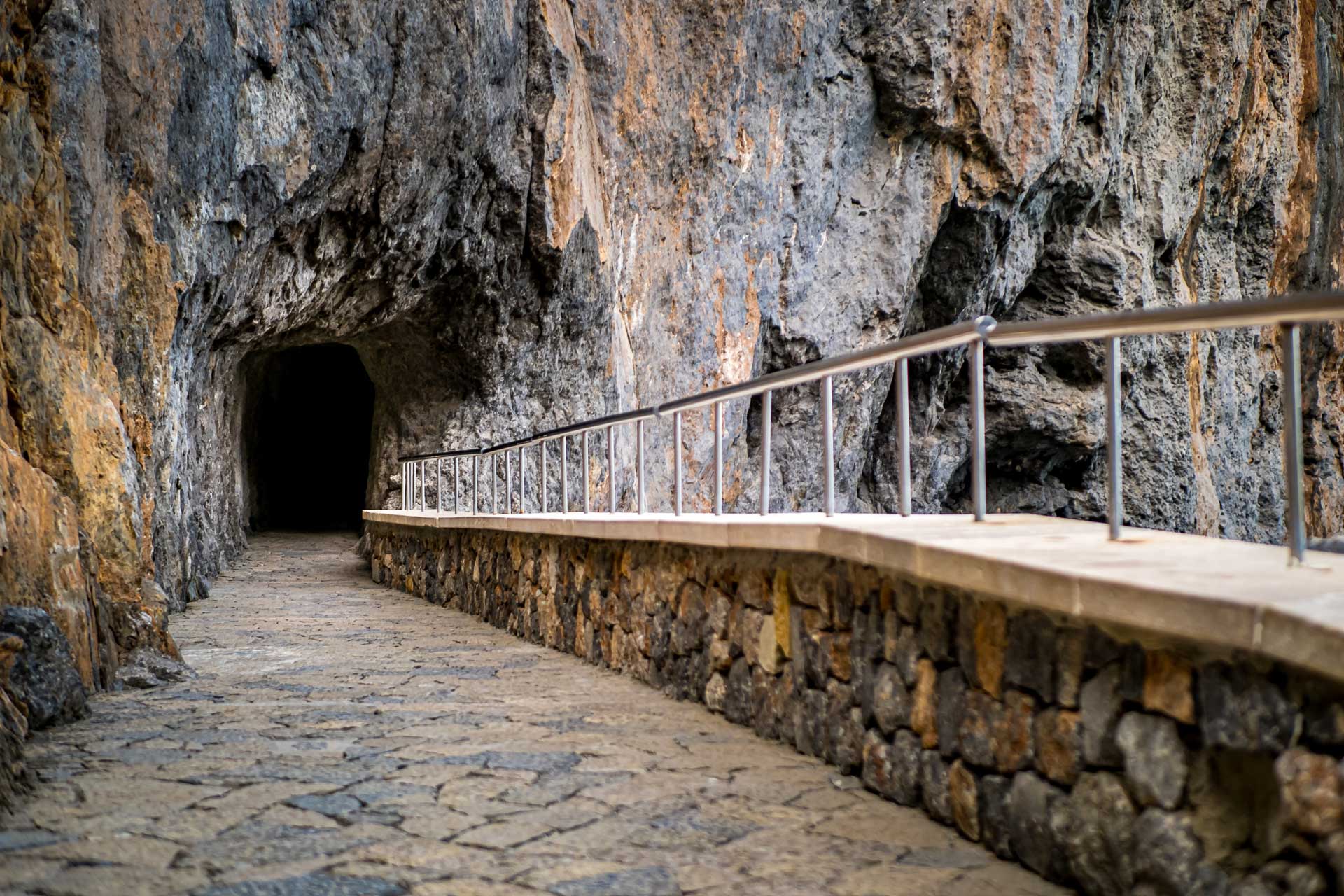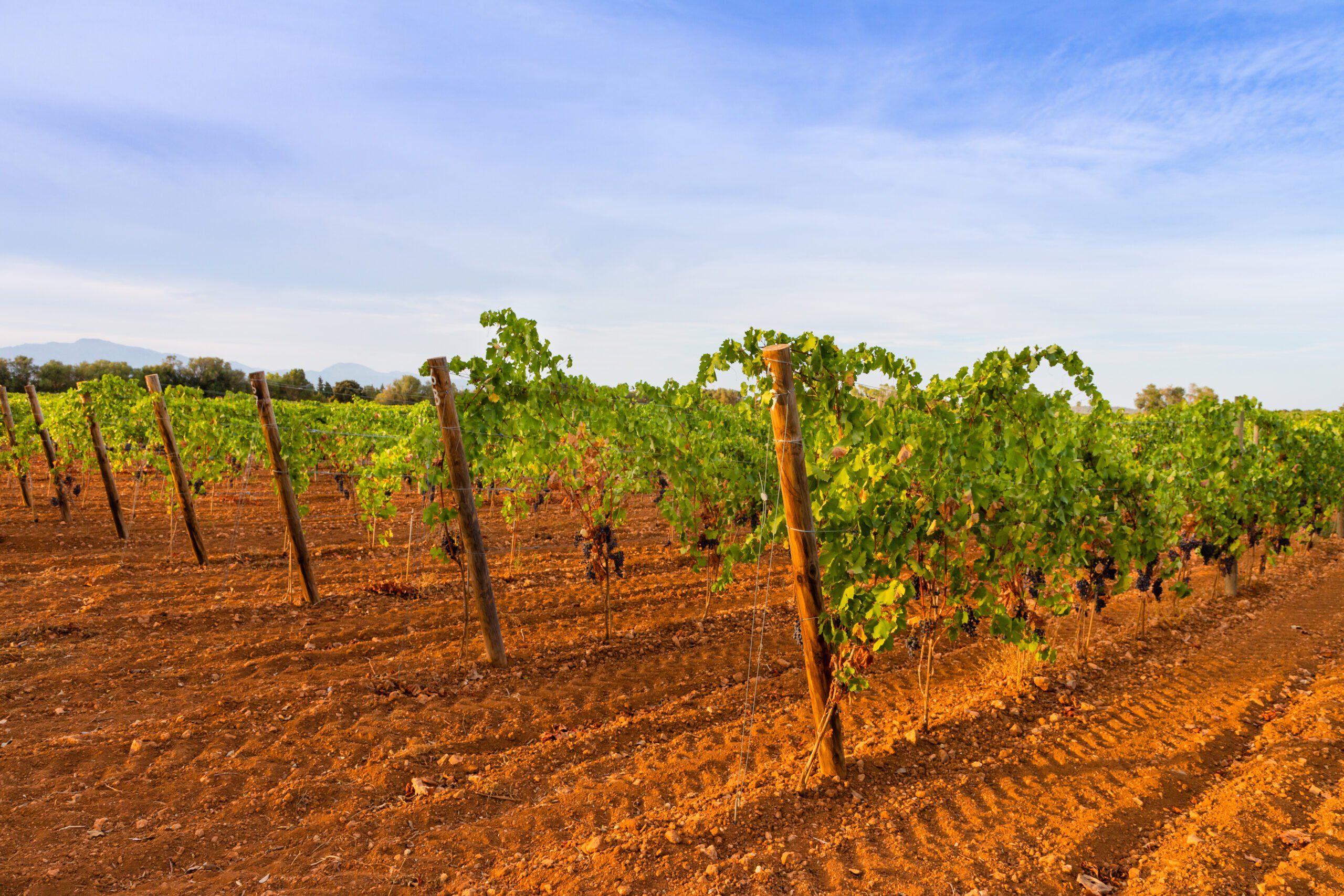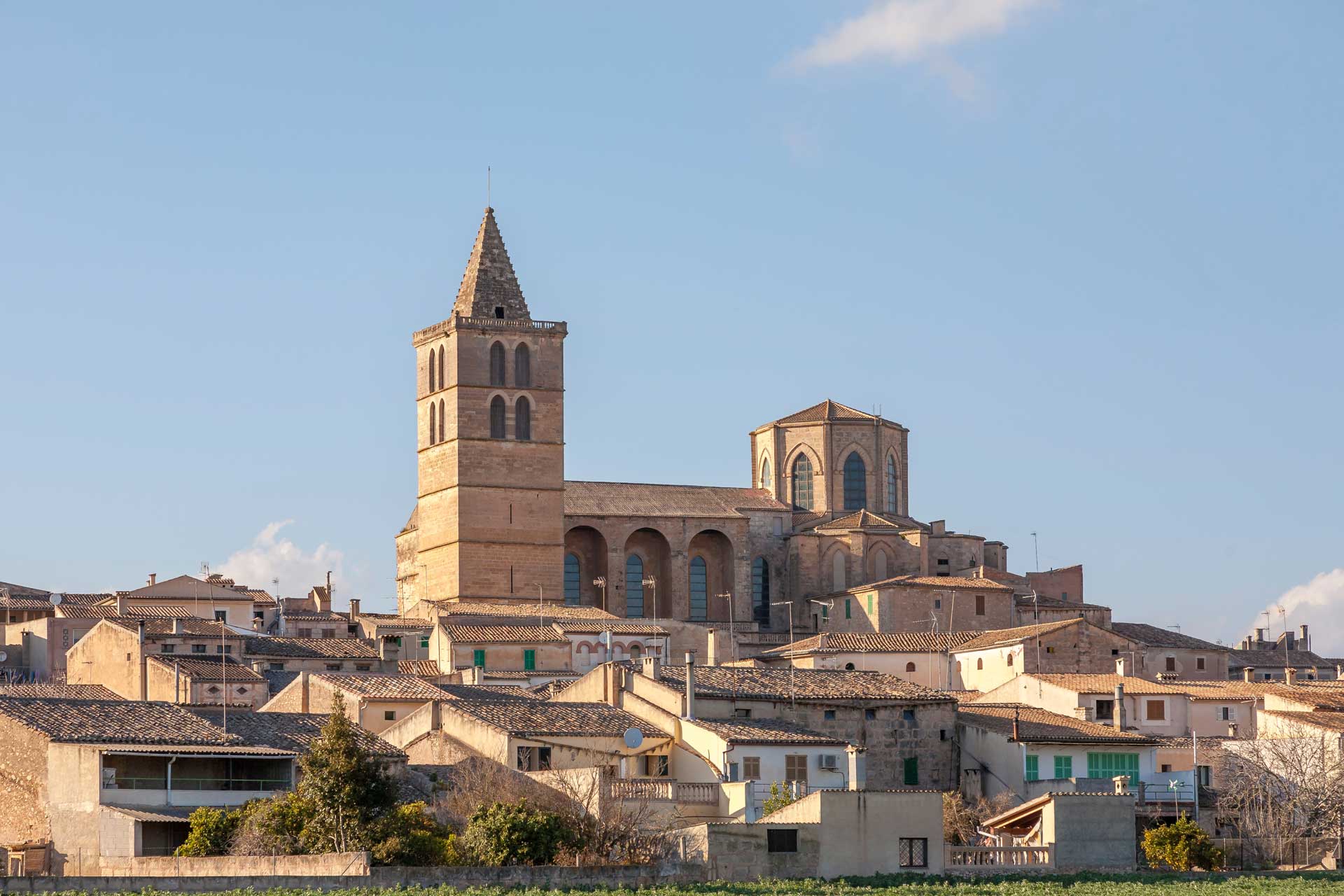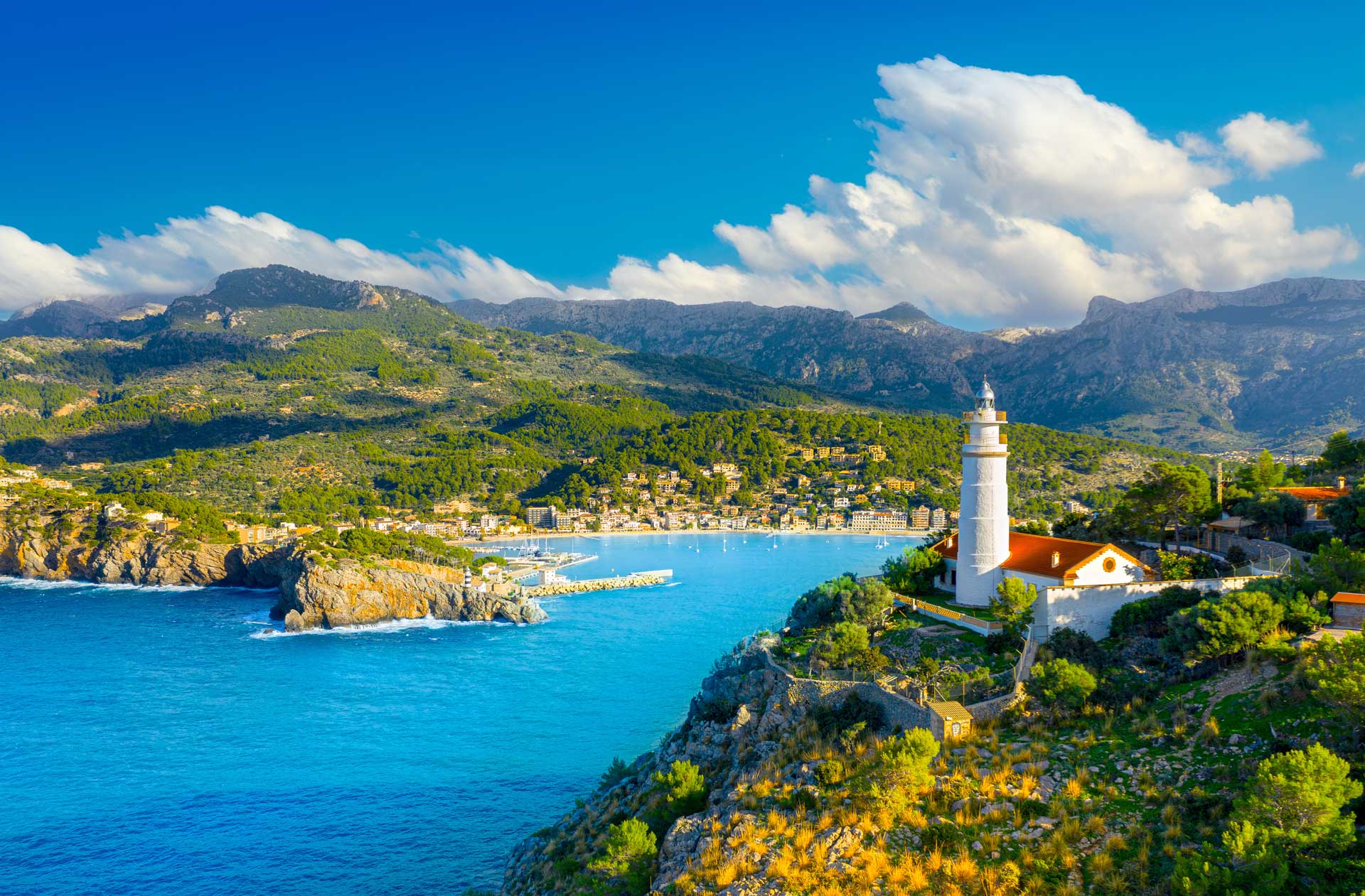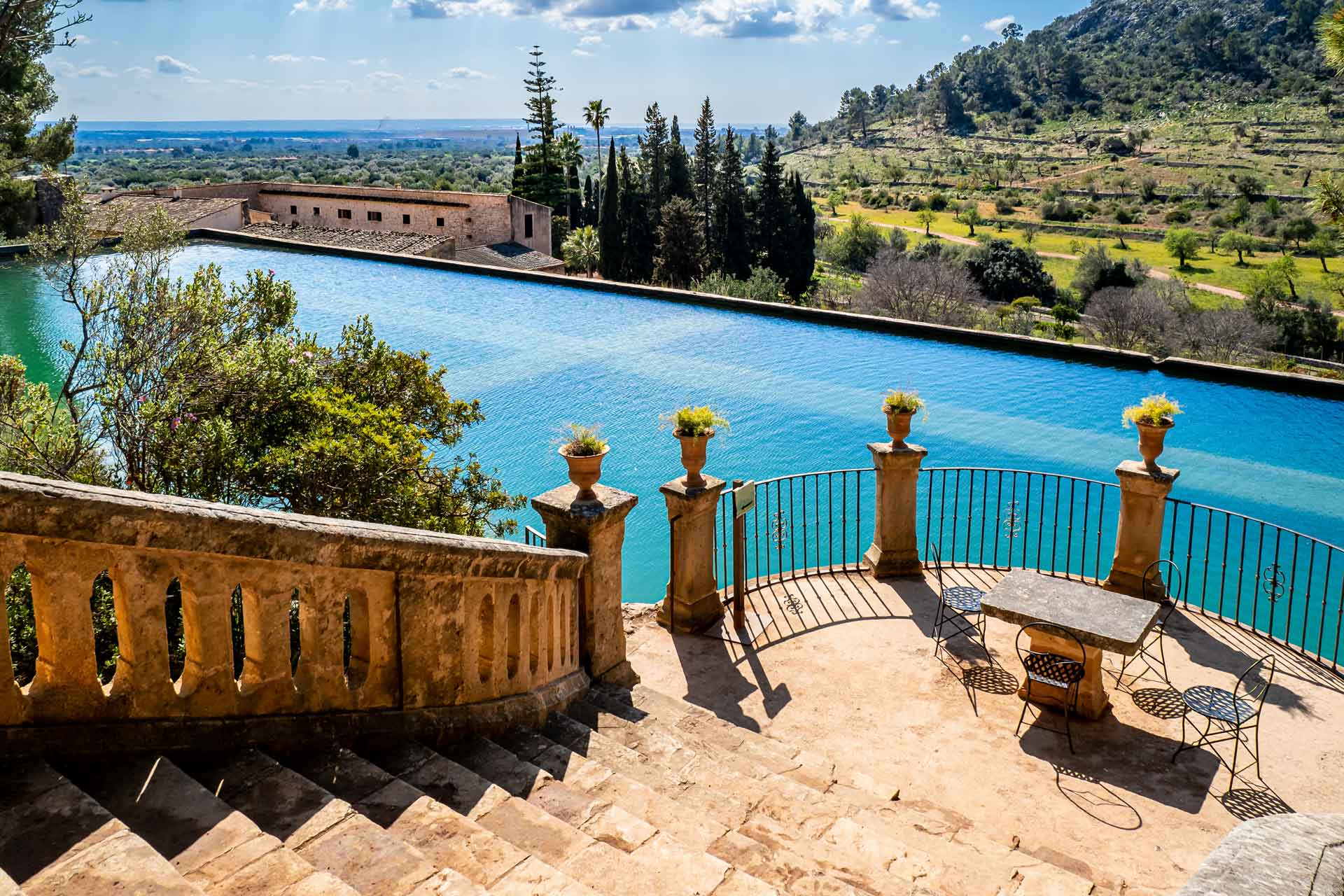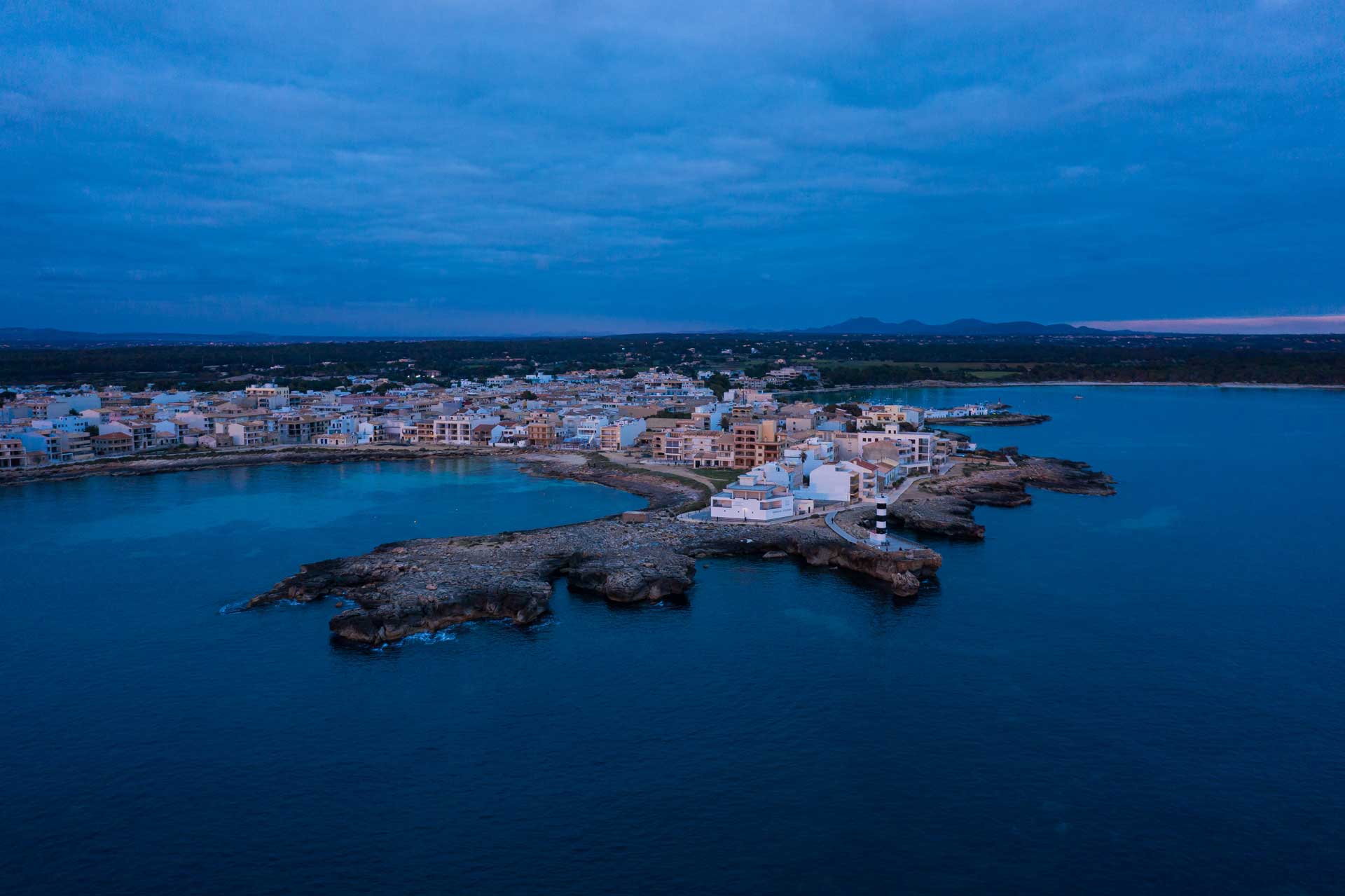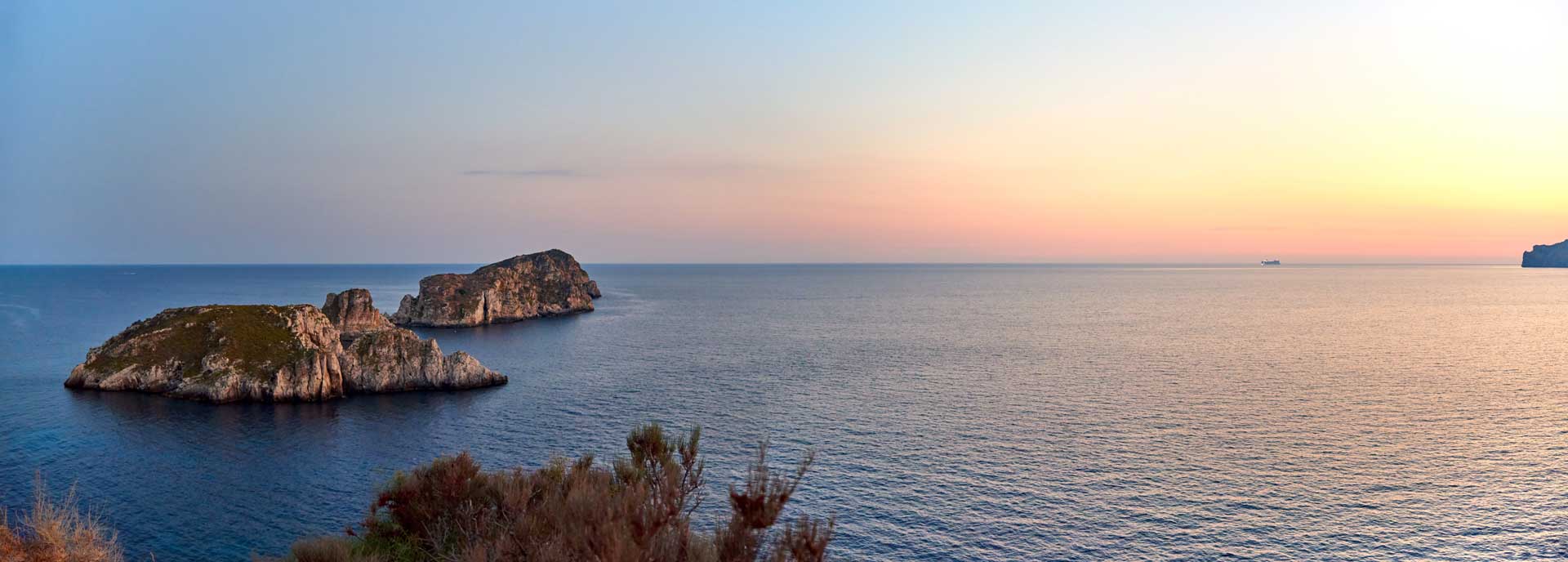Contenidos / Contents
What is Sa Calobra and why should you visit it?
Discovering Sa Calobra means understanding the essence of the Serra de Tramuntana, a place where nature and Mallorcan tradition come together in perfect harmony. This unique enclave is made up of three intertwined elements: a cove, a small village, and a natural environment of great value.
Sa Calobra: cove, village, and natural environment
The term “Sa Calobra” refers, on the one hand, to a small pebble beach sheltered by impressive cliffs that plunge into the sea. Its beauty lies in the purity of the landscape, where the intense blue of the Mediterranean contrasts with the rocky walls of the Serra de Tramuntana.
Next to the cove is a small cluster of houses and restaurants that maintain the traditional atmosphere of Mallorcan villages. Although geared towards visitors, this place retains its local character, with a cuisine that pays tribute to the flavors of the island.
However, the real star of Sa Calobra is the Torrent de Pareis, an impressive natural gorge that flows into the cove and has been sculpted over thousands of years by the action of the water. The combination of these three elements—sea, rock, and torrent—makes Sa Calobra one of the most stunning landscapes in Mallorca.
Ecological, geological, and heritage value
The Torrent de Pareis and its surroundings have been declared a natural monument due to their exceptional geological interest. Its vertical walls, which reach up to 200 meters in height, are a living testimony to the karst erosion that has shaped this part of the island, creating a unique and highly fragile ecosystem.
This enclave is not only notable for its geology. It is also home to habitats of flora and fauna endemic to Mallorca, with species adapted to the extreme conditions of the gorge. These include rock-dwelling plants and birds such as the peregrine falcon and the Balearic warbler, an endangered species.
Beyond its natural wealth, Sa Calobra is part of the island’s cultural heritage. Its inclusion within the protected area of the Serra de Tramuntana, recognized as a UNESCO World Heritage Site, underscores its importance not only as a tourist attraction but also as a symbol of Mallorcan identity.
Access to Sa Calobra is part of the adventure. The famous tie knot road in the heart of the Serra de Tramuntana
Visiting Sa Calobra is an experience that begins long before you reach the cove. The drive there is an unforgettable excursion in itself, thanks to the spectacular Ma-2141 road, one of the most iconic in Mallorca.
The Ma-2141 road: a journey through curves and dizzying landscapes
The usual starting point for those traveling from Palma or Sóller is the Coll dels Reis, at an altitude of over 600 meters. From there, a 14-kilometer descent begins along a route that winds its way through the mountains in a sinuous and fascinating manner.
The route includes more than 25 sharp bends, many of them at right angles, which challenge the driver’s skill and force them to proceed at a leisurely pace. Far from being a drawback, this slow pace allows you to enjoy spectacular views of the valleys, ravines, and cliffs of the Serra de Tramuntana.
The descent to Sa Calobra usually takes between 30 and 40 minutes, depending on how many stops you make at the viewpoints. It is common to stop to admire the landscape or take photographs, especially on clear days, when the blue of the sea can be seen in the distance like a promise.
An engineering masterpiece: the legacy of Antoni Parietti
The construction of the Sa Calobra road is a milestone in the history of infrastructure in Mallorca. Designed in the 1930s by Mallorcan engineer Antoni Parietti, this road was respectfully integrated into the landscape, taking advantage of the terrain without resorting to tunnels.
Parietti’s goal was twofold: to facilitate access to Sa Calobra and, at the same time, to turn the road itself into a tourist attraction. The route was designed to enhance the natural beauty of the mountain, offering travelers a panoramic experience that can be enjoyed curve after curve.
The “tie knot”: Mallorca’s most famous curve
Among the numerous curves along the route, the well-known “tie knot” stands out in particular. This is a 270-degree curve that crosses over itself via a bridge, creating a loop reminiscent of a knotted tie.
This ingenious solution made it possible to overcome a significant difference in height without altering the structure of the mountain. Today, the tie knot is one of the most photographed spots on the route and a symbol of the mastery with which this road was designed.
Driving to Sa Calobra on the Ma-2141 is much more than just getting from one point to another. It is a unique experience, in which the journey is an essential part of the destination.
Enjoy Sa Calobra upon arrival
Arriving at Sa Calobra after traveling along the Ma-2141 road is a reward in itself. The landscape changes suddenly: from the rugged rocks of the Serra de Tramuntana mountains to the sea, in a corner where nature has created a unique and breathtaking setting.
What you see and experience upon arrival
The first contact with Sa Calobra is usually through a pleasant walk through tunnels carved into the rock, a passageway that connects the parking lot with the beach area. These tunnels, originally built for pedestrians, allow you to walk between cliffs without disturbing the natural environment and offer small viewpoints overlooking the sea that give you a glimpse of the beauty of your final destination.
Upon arrival, visitors discover the peculiarity of the double cove. On one side is the pier cove, a small pebble beach where boats arriving from Sóller usually dock. It is an ideal place for those seeking tranquility by the sea, with access to basic services such as restaurants and restrooms.
A few meters further on is the Torrent Cove, where the Torrent de Pareis flows into the sea. This wilder-looking spot is the true emblem of Sa Calobra. Surrounded by imposing stone walls, it creates a natural amphitheater that takes the breath away of those who visit it for the first time.
Practical recommendations for enjoying your visit
The best time of year to visit Sa Calobra is in spring or early fall. These months offer pleasant temperatures and fewer visitors, allowing you to enjoy the place in greater tranquility. In summer, the popularity of the enclave can mean crowds, especially during the middle of the day.
Regarding access, it is important to consider the two main options:
- By road, ideal for those who want the full experience, enjoying the views and the drive along the Ma-2141.
- By boat from Sóller, a comfortable and scenic alternative, offering the opportunity to see the coast of the Serra de Tramuntana from the sea and avoiding parking complications.
In terms of equipment, it is essential to wear suitable footwear, preferably closed, as the terrain is rocky and slippery in some areas. It is also advisable to bring plenty of water, especially in the warmer months, and sun protection, as there is very little shade.
Visiting Sa Calobra means enjoying a unique natural environment, where every detail—from the access road to the last stone—is part of an authentic and memorable experience.
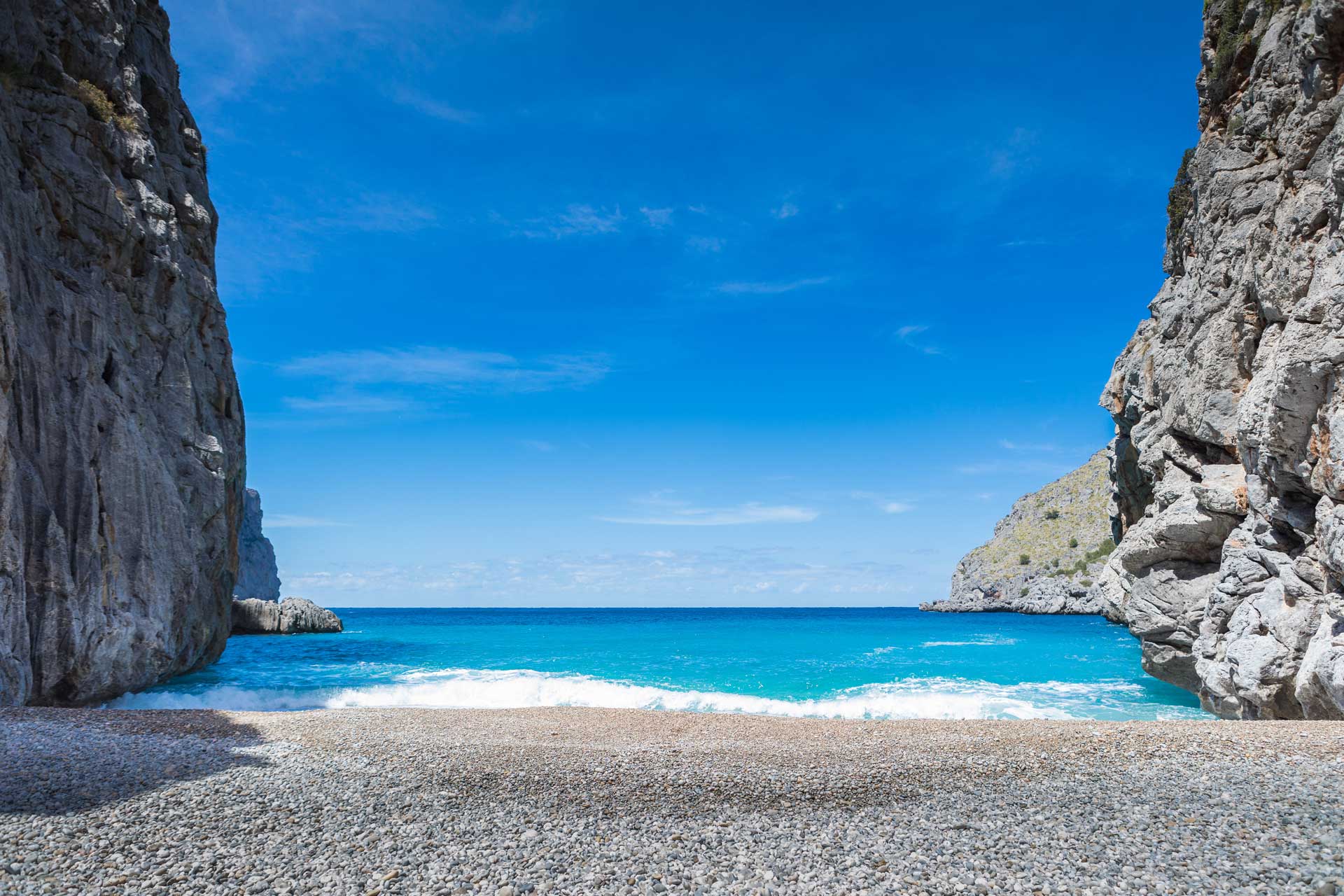
A stop with Mallorcan flavor: cuisine by the sea
After traveling along the access road and exploring the natural corners of Sa Calobra, there is nothing better than taking a break to enjoy the local cuisine. Although the center of Sa Calobra is small, it has several restaurants and cafés facing the sea, where you can taste typical dishes of the island in an unbeatable setting.
Local products and traditional recipes
The cuisine of Sa Calobra focuses on simple, high-quality products that are faithful to Mallorcan tradition. Among the most common dishes are:
- Pa amb oli: a slice of country bread rubbed with tomato and extra virgin olive oil and accompanied by local cold cuts such as sobrasada or camaiot, as well as cheeses from the island.
- Frito mallorquín: a hearty dish made with meat, potatoes, peppers, and vegetables, flavored with Mediterranean herbs.
- Grilled squid and other seafood, fresh and simply cooked to bring out their natural flavor.
- Mallorcan salads, ideal for hot days, with local ingredients such as olives, capers and spring onions.
Don’t forget to accompany your meal with a good vi de la Serra de Tramuntana, a designation that has gained prestige in recent years for its fresh, mineral wines, perfect for pairing with local cuisine.
Lunch with a view
Most establishments have terraces with views of the sea or the cliffs, creating a relaxed atmosphere where it is easy to linger over lunch. It is the ideal time to enjoy yourself without rushing, letting yourself be carried away by the leisurely pace that characterizes this part of the island.
To complete the experience, many travelers choose to try a Mallorcan ensaimada for dessert, accompanied by a coffee or herbal liqueur, ending lunch on a sweet and traditional note.
Making a gastronomic stop in Sa Calobra is not only a way to recharge your batteries, but also to connect with the authentic flavors of Mallorca, in a setting where the landscape and tradition can be savored at the same time.
Bars and restaurants in Sa Calobra and surroundings
La Calobra Restaurant
Located on the seafront, this restaurant offers Mediterranean cuisine with dishes such as paella and fresh fish. It is a popular choice among visitors looking for a complete meal in spectacular surroundings.
📍 Playa de La Calobra, 07315 La Calobra
📞 +34 971 517 016
Bar Playa
Located right on the beach, this bar stands out for its sea views. It is ideal for a refreshing drink while enjoying the scenery. It offers simple dishes such as grilled squid and salads.
📍 Urbanitzacio Sa Calobra 2, 07315 Escorca
📞 +34 971 517 032
GastroBar Torrent de Pareis
Close to the parking lot, this gastrobar offers a variety of dishes and is known for its carrot cake. It is a more economical option with good reviews from visitors.
📍 Carrer Port de Sa Calobra, 23B, 07315 La Calobra
Es Vergeret
Located in Cala Tuent, this restaurant offers traditional Mallorcan cuisine with specialties in rice dishes and fish. It stands out for its large terrace with panoramic views of the sea and mountains, providing an ideal setting to enjoy a quiet meal in the heart of the Serra de Tramuntana. It is a recommended option for those seeking an authentic gastronomic experience in a natural setting.
📍 Carretera Cala Tuent S/N, Cala Tuent (Escorca), Mallorca
📞 +34 971 51 71 05 / +34 669 715 990
Caution in the Torrent de Pareis: beauty that demands respect
When you arrive at Sa Calobra, it’s understandable that you’ll be tempted to venture into the majestic Torrent de Pareis. Its imposing rock walls, wild atmosphere, and sense of adventure make it the perfect place for an unforgettable excursion. However, it’s important to be aware of the difficulty and real dangers of this route.
The complete route of the Torrent de Pareis is not a typical hike. It is a demanding canyoning trip that involves overcoming natural obstacles such as boulders, narrow passages, areas of downclimbing, and unstable terrain. There is no marked trail. Only experience, knowledge of the terrain, and adequate physical preparation will allow you to complete it safely.
Every year, rescue teams have to intervene to help ill-prepared hikers who underestimated the risks. Conditions can change quickly: after rain, the riverbed can become impassable, and shaded and damp areas increase the technical difficulty.
For this reason, it is recommended that you do not attempt to walk the Torrent de Pareis unless you have:
- Proven experience in canyoning.
- Appropriate equipment for technical mountain terrain.
- Prior knowledge of the route and its critical points.
- Good physical condition and orientation skills.
If you want to enjoy the majesty of the Torrent de Pareis safely, I invite you to walk the first few meters from the cove, where you can admire its walls and feel the power of the landscape without taking unnecessary risks.
Experiencing nature with respect is the best way to protect yourself and preserve the beauty of this unique environment.
The grandeur of nature at Torrent de Pareis
Few places in Mallorca are as impressive as Torrent de Pareis, a monumental canyon that flows into the cove of Sa Calobra and is considered one of the most spectacular geological formations on the island.
Brief geological explanation
The Torrent de Pareis is a karst gorge formed over thousands of years by water eroding the limestone rock. The constant action of rain and currents has carved out a deep canyon, whose vertical walls reach up to 200 meters high in some sections.
This natural process has given rise to a rugged and awe-inspiring landscape, where the stream only carries water during periods of heavy rain, remaining dry for most of the year.
Natural and spiritual significance
Beyond its impressive formation, the Torrent de Pareis has great ecological value. Its microclimate, which is more humid and cooler than the surrounding area, allows for the presence of endemic plant species and fauna adapted to these extreme conditions.
In addition, this place has traditionally been a place of retreat and connection with nature. The grandeur of its walls and the isolation of the surroundings create an atmosphere of spirituality, much appreciated by hikers and visitors in search of authentic experiences.
Hiking route: difficulty, duration, and risks
The complete route of the Torrent de Pareis is one of the most emblematic and demanding hiking trails in Mallorca. The journey usually begins in Escorca, following the dry riverbed until it reaches its mouth at Sa Calobra.
- Duration: between 4 and 5 hours, depending on the experience of the group and the conditions of the terrain.
- Difficulty: high. The route involves jumping between rocks, narrow passages, climbing down and slippery areas.
- Risks: it is not advisable to do the route after rain or when storms are forecast, as the stream can fill up quickly with water. It is also essential to be equipped with suitable footwear, plenty of water and, preferably, accompanied by a guide who knows the area.
For those who prefer a more accessible experience, it is possible to enter the gorge a few meters from the cove and enjoy its monumentality without having to complete the entire route.
Consideration as a natural monument
The geological and ecological uniqueness of the Torrent de Pareis has led to its declaration as a natural monument by the Government of the Balearic Islands. This protection guarantees the conservation of its valuable ecosystem and regulates the activities permitted in its surroundings.
Being part of the Serra de Tramuntana, recognized as a UNESCO World Heritage Site, reinforces its importance as an icon of the landscape and biodiversity of Mallorca.
Natural acoustics and occasional small concerts
One of the lesser-known curiosities of the Torrent de Pareis is its exceptional natural acoustics. The high walls of the canyon create a resonance effect that turns the place into an open-air amphitheater.
Taking advantage of this peculiarity, small concerts and choral performances have occasionally been held at the mouth of the stream, offering the public a unique sound experience in an incomparable setting.
Listening to a concert in the Torrent de Pareis is a privilege reserved for special moments, where music and nature merge in perfect harmony.
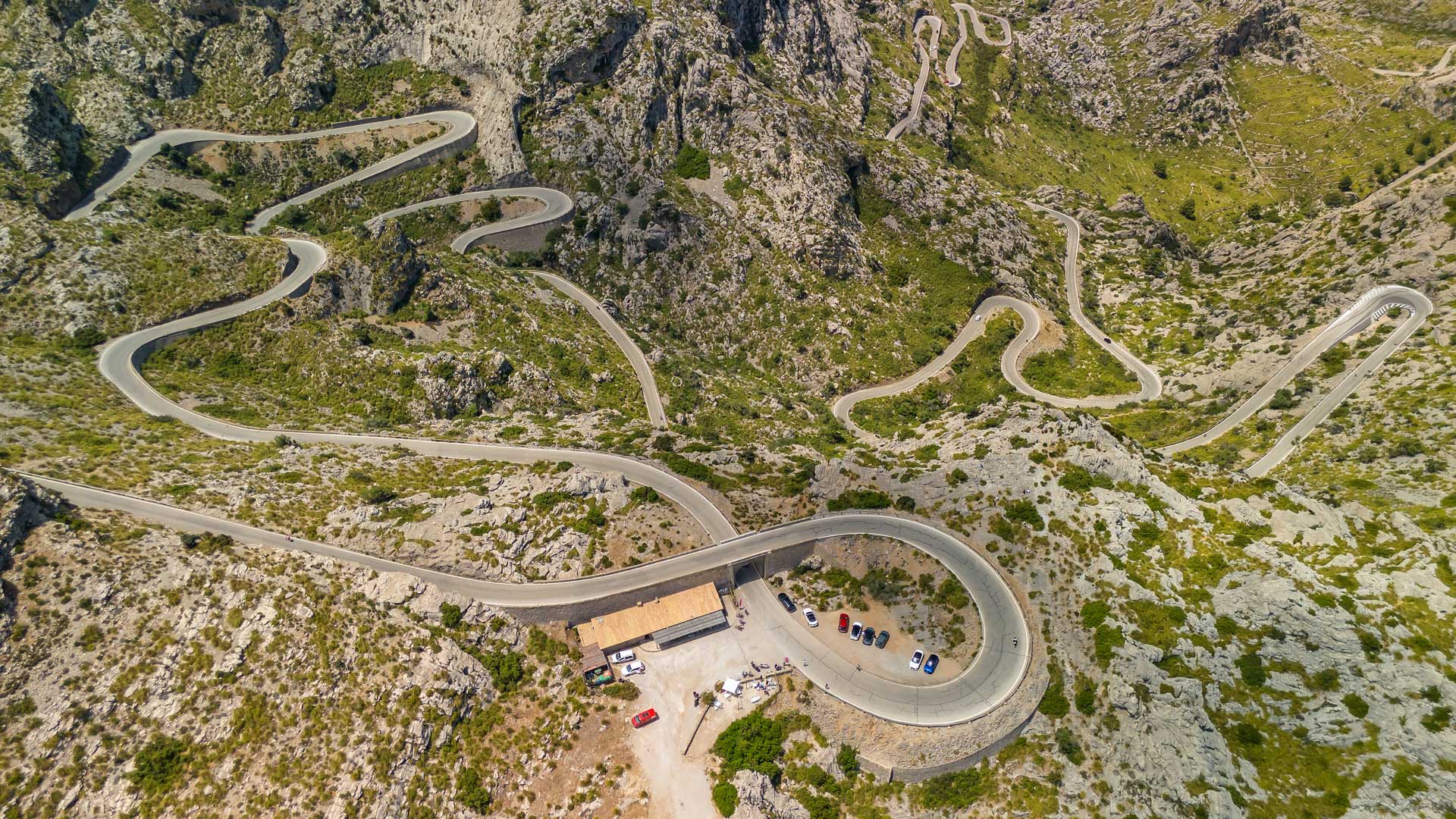
The annual concert at Torrent de Pareis
Every summer, Torrent de Pareis becomes the setting for one of the most unique cultural events in Mallorca: the annual choral concert, a tradition that combines the beauty of the natural environment with the musical richness of the island.
A natural amphitheater with exceptional acoustics
The choice of Torrent de Pareis as the venue for this event is no coincidence. Its vertical walls, over 200 meters high, create exceptional natural acoustics, comparable to those of large auditoriums. The sound is projected and resonates in an enveloping way, creating a unique listening experience for performers and audience alike.
The setting, far from noise and distractions, turns each note into a moment of communion between music and nature, amplifying the emotion of the performances.
A tradition that celebrates Mallorcan culture
The concert at Torrent de Pareis is usually held in July and is organized by various local institutions, including the Escorca Town Council and cultural organizations from Mallorca. Its origins date back to the mid-20th century, with the aim of promoting both the island’s natural heritage and its musical tradition.
The event usually brings together Mallorcan choirs and vocal groups, although international groups have also participated in some editions. The repertoire ranges from traditional Balearic music to classical and contemporary pieces.
An unmissable event for music and nature lovers
For many travelers and residents, attending this concert is one of the most memorable experiences of the Mallorcan summer. The combination of art and landscape, in a place that is difficult to access, makes the evening an intimate and special moment.
Due to the unique nature of the location, the audience sits on the rocks of the stream in an informal and respectful atmosphere. Admission is usually free, but seating is limited, so it is recommended to arrive early to secure a good spot.
This event is also an opportunity to experience the Torrent de Pareis from a different perspective, away from the crowds and with a cultural focus that highlights its value as a natural monument.
Sa Calobra como plató cinematográfico, el escenario natural que conquista cámaras
La espectacularidad de Sa Calobra no ha pasado desapercibida para el mundo del cine, la publicidad y la fotografía. Su combinación de paisaje abrupto, luz natural y entorno virgen la ha convertido en un lugar muy codiciado por productores y artistas de todo el mundo.
Películas rodadas en Sa Calobra
Entre las producciones más destacadas, figura la superproducción internacional “Cloud Atlas” (2012), dirigida por los hermanos Wachowski y Tom Tykwer. Parte del metraje se grabó en la desembocadura del Torrent de Pareis, aprovechando la majestuosidad de sus paredes y la atmósfera casi irreal del enclave. La película, protagonizada por actores de la talla de Tom Hanks y Halle Berry, mostró Sa Calobra en escenas que requerían paisajes de gran impacto visual.
Anuncios de coches: curvas y belleza salvaje
La carretera Ma-2141, con su famoso nudo de la corbata, ha sido escenario habitual de anuncios de automóviles de marcas de prestigio como BMW, Audi, Porsche y Mercedes-Benz. Las curvas cerradas, el desnivel y las vistas espectaculares ofrecen un marco perfecto para transmitir sensaciones de potencia, control y placer de conducción.
Estos rodajes suelen aprovechar los primeros meses del año, cuando la afluencia de turistas es menor y las condiciones de luz son óptimas para filmar.
Motivos por los que se elige Sa Calobra para rodajes
El atractivo de Sa Calobra como localización se basa en varios factores:
- Variedad paisajística en un espacio reducido: acantilados, mar, cañones, carreteras panorámicas y espacios peatonales únicos.
- Accesibilidad controlada: aunque el acceso es complejo, la existencia de la carretera Ma-2141 permite trasladar equipos de rodaje de manera viable.
- Luz natural privilegiada: la orientación y la pureza del aire en la Serra de Tramuntana ofrecen una calidad lumínica ideal para fotografía y vídeo.
- Escenario virgen: la escasa urbanización preserva la autenticidad del paisaje, lo que resulta muy valorado en producciones que buscan entornos naturales.
Myths, legends, and traditions: the stories surrounding Sa Calobra
Beyond its natural and scenic value, Sa Calobra is a place shrouded in a halo of folk tales, legends, and beliefs passed down from generation to generation in the municipality of Escorca. These stories are part of the collective imagination of the Serra de Tramuntana and add a magical dimension to any visit.
The origin of the name: the Tramuntana snake
The name “Sa Calobra” comes from the word “colobra,” which in Mallorcan refers to a large snake. According to tradition, these snakes inhabited the cliffs and streams of the area in ancient times. The winding road and the undulating shapes of the Torrent de Pareis feed this visual association, evoking the image of a large reptile coiled between the mountains.
Although there is no evidence of the presence of giant snakes, the myth has endured and become part of the local identity as a symbol of the wild and untamed character of the area.
Tales of shipwrecks and pirates
The rugged coastline of Sa Calobra was, for centuries, the scene of shipwrecks and a refuge for pirates and smugglers. Local stories tell of ships crashing against the rocks during storms, leaving behind tales of sunken treasures and wandering souls.
It is also said that, taking advantage of the difficult access to the area, the nearby coves served as a hideout for Barbary pirates and smugglers, who thus avoided control by the Mallorcan authorities. These legends are mixed with the real history of the pirate raids that ravaged the island between the 16th and 18th centuries.
The story of the hermit and local beliefs
One of the best-known legends in the area is that of the hermit of Sa Calobra, a man who, fleeing the sorrows of the world, retired to live in a cave near the Torrent de Pareis. It was said that his austere life and connection with nature gave him wisdom and healing powers.
The people of Escorca came to him in search of natural remedies and spiritual advice. Although his figure has faded over time, his story lives on in oral tradition, representing the values of simplicity, respect for nature, and ancestral wisdom.
Oral transmission in the municipality of Escorca
All these legends and stories have been kept alive thanks to oral transmission in the municipality of Escorca. At family gatherings, popular festivals, and neighborhood meetings, the stories of Sa Calobra continue to be told, enriched with details and variations that reflect popular creativity.
This intangible heritage is part of the cultural identity of the Serra de Tramuntana and makes Sa Calobra a place where landscape and legend are inextricably intertwined.
Places of interest nearby: what to discover beyond Sa Calobra
A visit to Sa Calobra is just one part of the wealth offered by the Serra de Tramuntana. A few kilometers away, travelers can continue exploring other enclaves that combine nature, culture, and tradition, perfect for rounding off a day or planning new excursions.
Santuari de Lluc: the spiritual heart of Mallorca
The Santuari de Lluc is one of the most emblematic places in Mallorca, both for its religious importance and its cultural and natural value. Located about 20 kilometers from Sa Calobra, this monastery has been a center of pilgrimage and a symbol of Mallorcan identity for centuries.
In addition to its basilica and the image of the Mare de Déu de Lluc, the sanctuary houses a botanical garden, a small museum, and a famous escolania (children’s choir) that offers regular concerts. The surroundings, surrounded by forests and mountain trails, invite contemplation and enjoyment of nature.
Fornalutx, Escorca, and Sóller: charming traditional villages
- Fornalutx is known as one of the prettiest villages in Spain. Its cobbled streets, stone houses, and flower-filled balconies create an authentic and welcoming atmosphere. It is ideal for strolling and enjoying the traditional architecture of the mountains.
- Escorca, although scattered in small estates and farmhouses, reflects the most rural essence of the Tramuntana. Here, life passes at the pace of nature, and its landscapes of olive groves and dry stone terraces are part of the cultural heritage of Mallorca.
- Sóller, with its historic square, modernist church, and tram connecting it to the port, is a must-see. Its local market, artisan shops, and gastronomic offerings invite you to enjoy a complete experience.
Alternative hiking trails in the area
For nature lovers and hikers, the area offers many interesting trails:
- Camí des Barranc: an old charcoal burners’ path that descends to Sa Calobra, less well known but very picturesque, ideal for those looking for less traveled routes.
- Ruta del Puig Roig: a circular excursion that combines ethnological heritage, spectacular views, and direct contact with nature. Prior permission is required, as it crosses private property.
- Ruta del santuari de Lluc a Caimari: a classic route that allows you to enjoy the beauty of the landscape while following in the footsteps of ancient pilgrimage routes.
These routes allow travelers to explore the Serra de Tramuntana at a leisurely pace, discovering unique landscapes and delving deeper into the culture of the island.
How to enjoy Sa Calobra at your own pace
Visiting Sa Calobra is an unforgettable experience, but to enjoy it to the fullest, it is important to keep in mind some practical aspects that will make a difference during your visit.
Recommended times of year depending on the type of experience
The best time to visit Sa Calobra depends on what you are looking for:
- Spring (April and May): ideal for enjoying pleasant temperatures, nature at its best, and fewer tourists.
- Early fall (September and October): good weather and a quieter atmosphere after the high season.
- Summer (July and August): recommended only if you want to enjoy swimming and don’t mind the crowds, although it’s best to go early in the morning or at sunset.
In winter, the place retains its beauty, but the weather conditions may make a visit less advisable, especially if there has been recent rain.
How to avoid the crowds
Sa Calobra is a very popular destination, so it is important to plan your visit to avoid the busiest times and days:
- Avoid the middle of the day (11 a.m. to 4 p.m.), especially in summer.
- Weekdays are always quieter than weekends.
- Arriving first thing in the morning or late in the afternoon allows you to enjoy the place in a more peaceful setting with perfect light for photography.
- Consider the option of arriving by boat from Sóller, thus avoiding parking and enjoying a different perspective of the coast.
Alternatives for families or experienced hikers
- For families with young children, it is best to limit your visit to the cove area and the start of the Torrent de Pareis, where access is easy and safe.
- For experienced hikers, the complete route of the Torrent de Pareis from Escorca is an unforgettable challenge, but only recommended for people who are in good physical condition and have mountain experience.
- Other routes such as the camí des Barranc offer lesser-known but equally attractive alternatives for hikers looking to avoid the more crowded areas.
Available services: restaurants, restrooms, and parking
In Sa Calobra, you will find basic services to make your visit more comfortable:
- Restaurants: small restaurants and cafes next to the cove offer typical Mallorcan dishes, sandwiches, and drinks. The selection is simple but sufficient for a pleasant break.
- Public restrooms: available in the pier area, although capacity is limited during high season.
- Parking: there is a paid parking area located a short distance from the cove. On busy days, it can fill up quickly, so arriving early is essential.
It is important to remember that, as this is a protected natural area, there are no supermarkets or large shops, so it is advisable to bring water and sunscreen with you.
